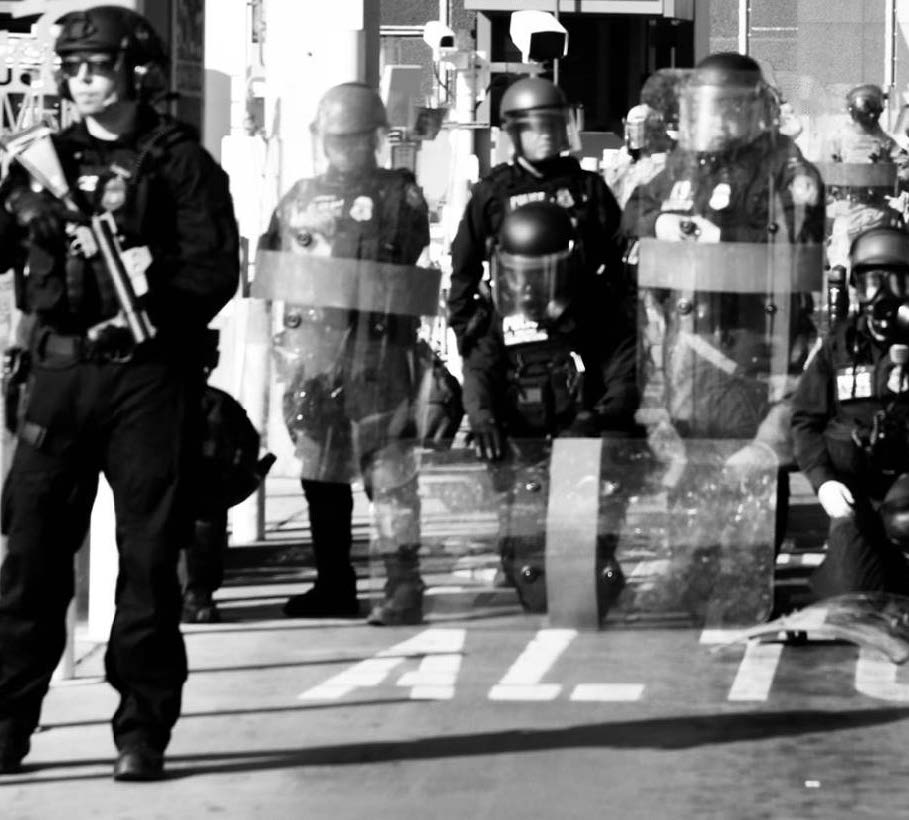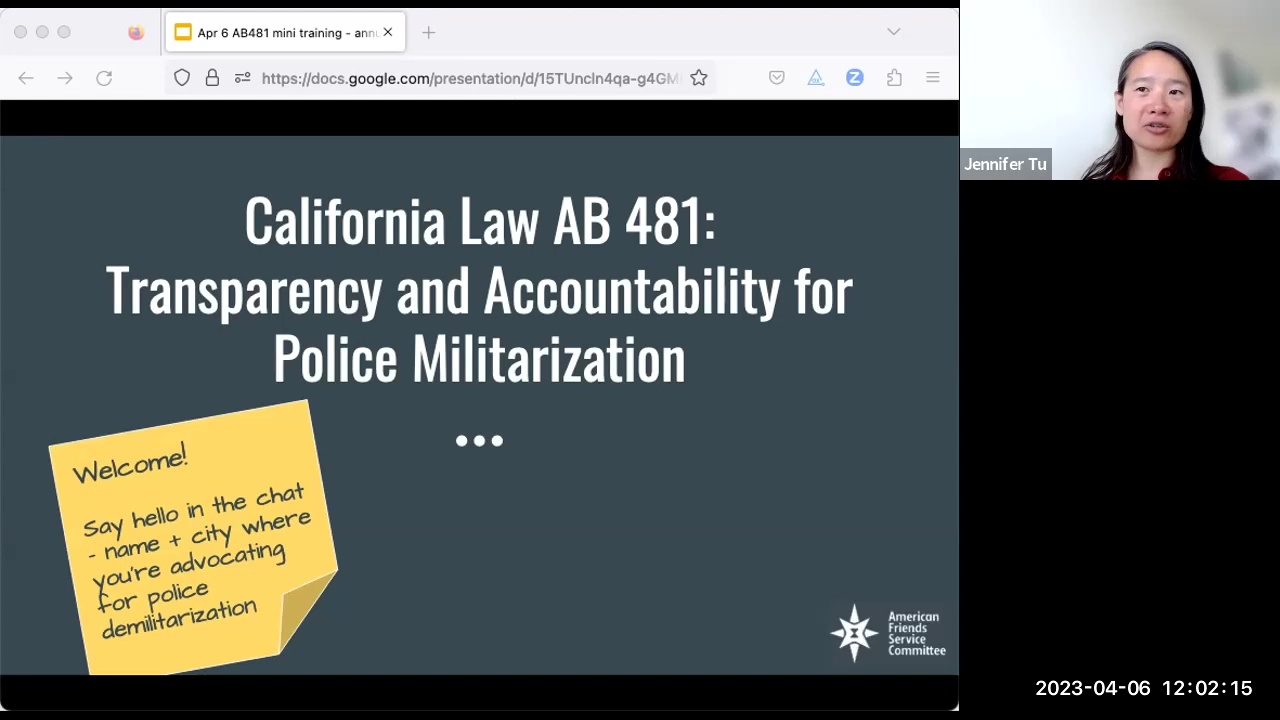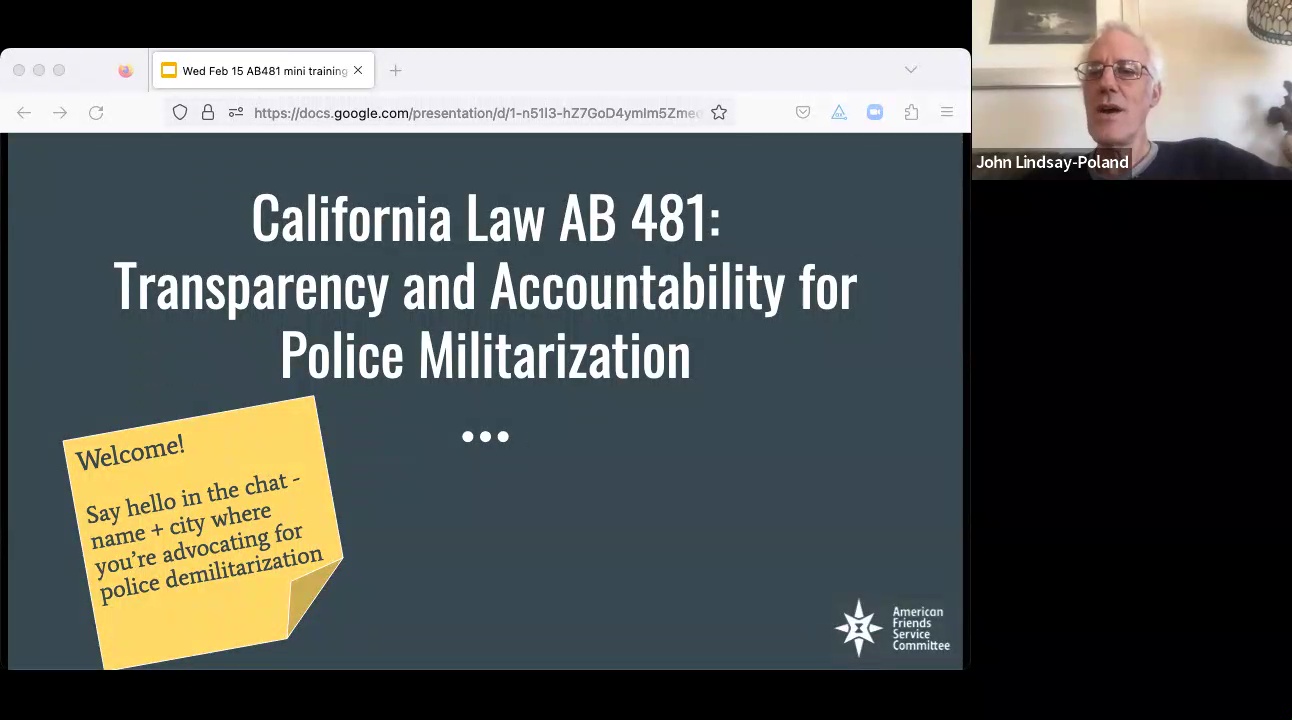
Reports Toolkit To Deconstruct Militarized Police Narratives
This is an advocacy toolkit for community members to respond to police and sheriffs' military equipment annual reports, and to take action during the City Council/County Board of Supervisor's policy review process that is required by AB481 on an annual basis.
Why annual reports are important
For the first time in 2022, police and sheriffs in California were required to disclose what militarized weaponry they possess and propose policies or when they can and can’t use it, as a result of a state law signed in 2021, AB 481. But the policies approved by local officials across the state are only as good - or as bad - as how law enforcement practices them.
This year, again for the first time, more than 500 police and sheriff departments will be required to report to the public and to elected officials on how and why they have deployed assault rifles, impact projectiles, armored vehicles, drones, robots, and other gear, and how much these deployments cost. Agencies must also respond to questions and comments about their report in a “well-publicized and conveniently located community engagement meeting.” At least as important, after the reports are published, elected officials will decide what kinds of use, if any, should be authorized for military equipment in the next year. They must do so in public hearings open to community comment.
How well we use this opportunity to push back on militarized policing depends partly on whether police and sheriff reports shine a light on or obscure how these weapons are deployed, how often, and who in the community has been most impacted. This guide is designed to help community members, elected officials and journalists make the most of the new California requirement for annual reports to illuminate police use of militarized equipment in our communities.
What AB 481 requires for annual reports
AB 481 requires “at a minimum” six elements in annual report for each type of equipment:
- A summary of how each type of equipment was used and the purpose of that use;
- The quantity possessed of each type of equipment
- Annual costs for each type of equipment, “including acquisition, personnel, training, transportation, maintenance, storage, upgrade, and other ongoing costs”
- Summary of complaints or concerns received for each type of equipment;
- Information disclosing violations of military equipment policies and actions taken in response, as well as result of internal audits; and
- Plans to acquire additional military equipment in the coming year, and the quantity sought.
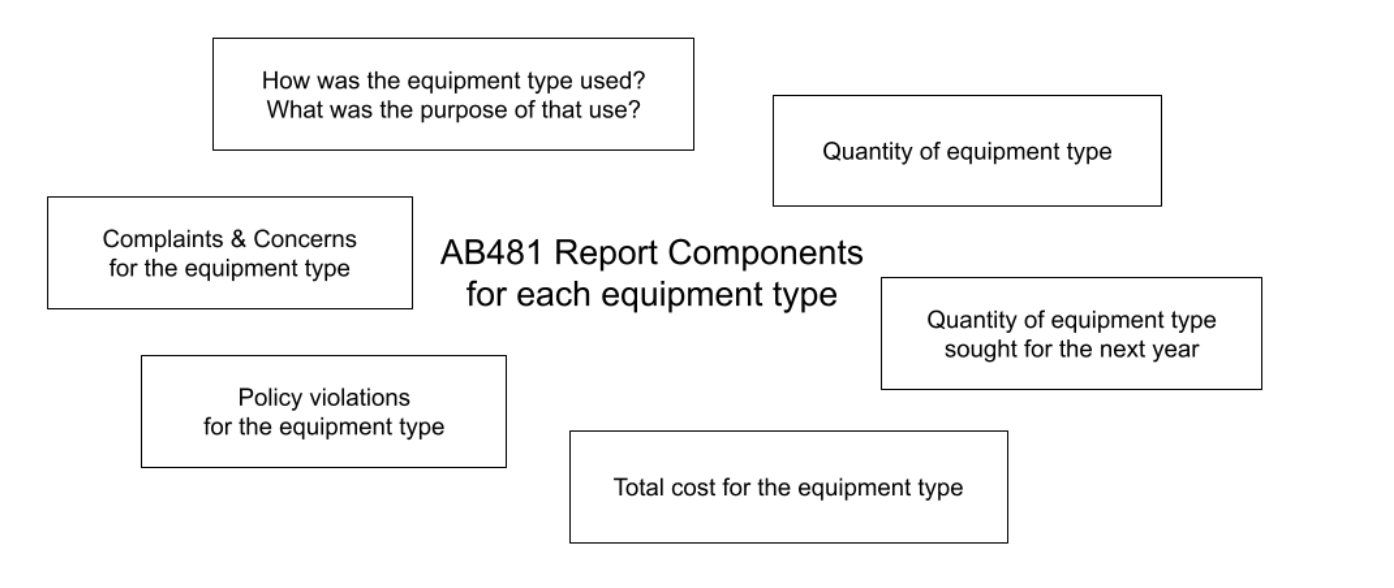
Because this is the “minimum” defined by AB 481, governing bodies have the authority to require additional information.
Community engagement meetings: Agencies are also required by AB 481 to “hold at least one well-publicized and conveniently located community engagement meeting, at which the general public may discuss and ask questions” about the agency’s funding, acquisitions, policies and use of military equipment.
These meetings will be opportunities for law enforcement to present “copaganda”: to say how military equipment saves lives and protects the public from active shooters and bad guys, and why they believe law enforcement needs that and more. 481 also requires report disclosure of community risk and harm
But the community engagement meetings are also opportunities for community organizing and action. Many of these meetings are likely to be in-person, or hybrid in-person/virtual. Whatever the format, community members can make collective statements, and highlight omissions, harms, risks, and ways to reduce those risks - including restricting the use or getting rid of military equipment. Community members can use the public meetings to ask pointed questions, recount experiences, share poetry, and put both law enforcement and elected officials on notice that community members are watching and evaluating their responses. (See the sample scorecard below.)
Timeline for Annual Reports
These use reports are required on an annual basis, but the timing is relative to when the initial use policy was approved.
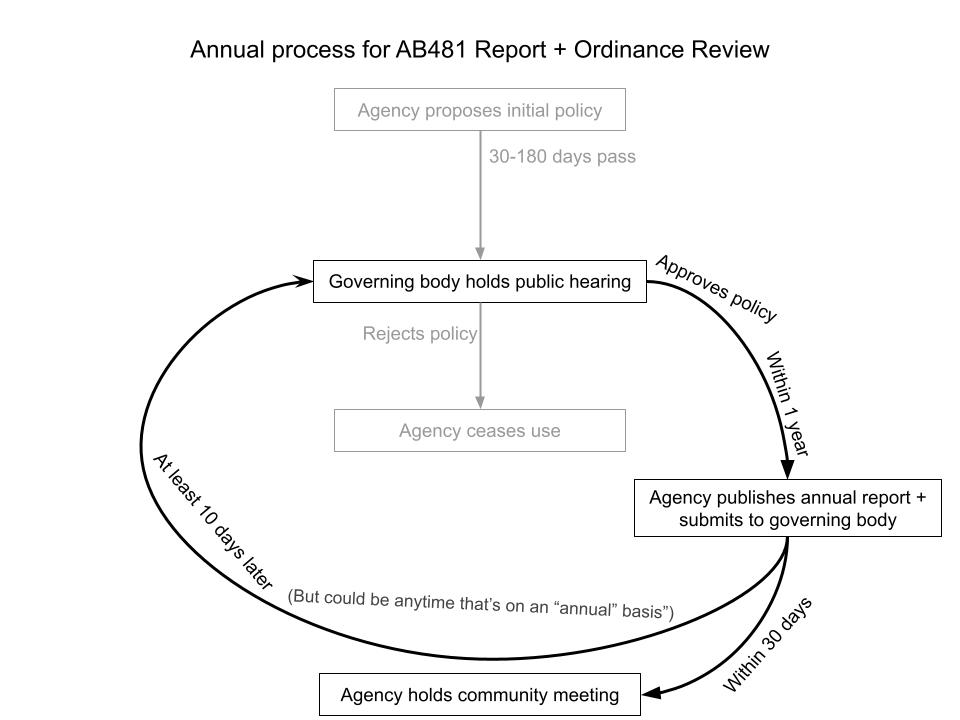
Within one year of the governing body (City Council / County Board of Supervisors) passing the military equipment use policy by ordinance, the law enforcement agency (LEA) must provide a use report. This report must happen within one year of the policy approval, but it could happen before the precise one-year mark.
The use report must be both submitted to the governing body, and also posted on the agency's website.
Within 30 days of submitting and publicly releasing an annual military equipment report pursuant to this section, the law enforcement agency shall hold at least one well-publicized and conveniently located community engagement meeting, at which the general public may discuss and ask questions regarding the annual military equipment report and the law enforcement agency’s funding, acquisition, or use of military equipment.
There is no requirement for how soon after the submit/release this could happen, so if the LEA were to schedule a community meeting for May 20, they could theoretically submit or release their use report on May 20 minutes before the meeting begins and still follow the letter (but not the spirit) of the state law.
Separately, the City Council is required by state law to review its ordinance at least annually, and make a determination based on the annual report. There are no specific date requirements beyond "at least annually" and that they must make a determination based on the annual report. The Brown Act means that the governing body's public meeting can't happen until 10 days after receiving the report from the LEA, and that meeting must permit public comment on the agenda item.
Use Report Deadlines
Who: Law enforcement agency
What: Use reports “for each type of military equipment”
When: Within one year of the governing body approving the use policy
How: Use report must be submitted to the governing body and also published on the agency's web site
Who: Governing body (City Council or County Board of Supervisors)
What: Review use policy and make a determination based on submitted use report for whether to modify, renew, or reject policy.
When: At least annually
How: Vote at a Brown Acted meeting (e.g. item must be agendized with sufficient notice, and public comment must be permitted)
There are at least four ways to use the annual report to advocate for police demilitarization:
- Speak with your elected officials (Councilmembers, County Supervisors) ahead of public meetings.
Many elected officials are unaware that state law makes it their responsibility to review the policy on an annual basis. This is a good time to advocate for policy changes (see our Policy Toolkit for talking points) - Make statements to local media outlets about military equipment use.
- Give public comment at the City Council/County Board of Supervisor's meeting
- Demand answers at the law enforcement agency's community meeting
Use the following section to create the talking points you need for these different scenarios.
Issues to Raise
Below are a few common issues we've seen in use policies. We encourage you to use the following sections to raise questions and concerns in public meetings on the military equipment's annual use report, and in public meetings to reconsider the military equipment's use policy.
Use (deployment) vs. Use of force
AB 481 requires information on how equipment “was used” and the purpose of that use.
Annual reports must document information on when weapons or equipment were deployed, not only when force was used. AB 481 requires that policy govern all uses, which clearly includes deployments. AB 481 never limits policy or reporting to “uses of force.”
Who is impacted by military equipment?
AB 481 begins with a finding that “Military equipment is more frequently deployed in low-income Black and Brown communities, meaning the risks and impacts of police militarization are experienced most acutely in marginalized communities.” Multiple studies show that police overall use force disproportionately against people of color, especially Black people. It is therefore critical that the annual reports on use of military equipment document, as much as possible, who is impacted by these deployments.
Annual reports should disclose, for each type of equipment, at the very least, information on the race, gender, age, location, and disability status of persons who were the objects of the deployments of military equipment.
These reports should show the number of deployments for each demographic. Law enforcement agencies already gather demographic information on who is impacted by uses of force, which can be expanded in reports on deployment of military equipment.
Costs of military equipment
The documentation of costs of use by police and sheriffs of military equipment is a central accountability requirement in AB 481, which includes the cost of personnel time, something that is frequently much more expensive than the initial cost of buying the equipment itself.
This information also permits community members and elected officials to better assess the opportunity costs of military equipment. The time that law enforcement officers are maintaining or training on rifles also orients officers to weapons and emphasizes their use over other options. That time is not used by police or non-law enforcement providing other critically needed community services.
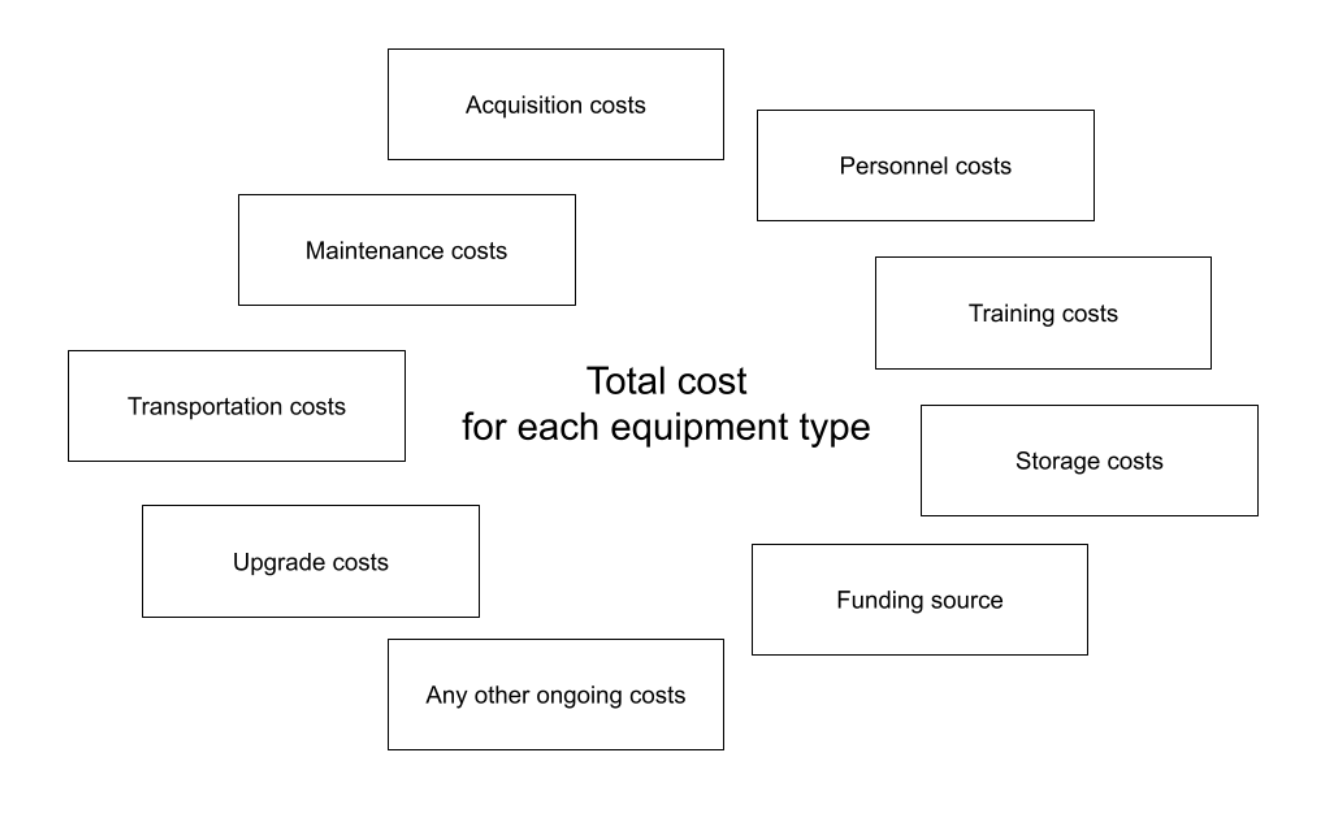
Use this scorecard to rate your local law enforcement agency's AB481 annual report on use of military equipment.
How much does the agency comply with AB 481 requirements for the use report?
- Did the agency post its report within a year of approval of the military equipment policy by the governing body?
- Is the annual report easily accessible and findable on the agency’s web site? (If it requires knowing the direct URL of the annual report, then the answer is no.)
- (Not required by law) Does the report link to the current policy and equipment inventory?
- Does the report give information on each type of equipment (defined in AB 481 as “each item that shares the same manufacturer model number”)?
- Does the report include full information on annual costs and the source of funds for those costs?
- Does it include, for each type of equipment, the cost of the following:
- Personnel (includes time spent on training, maintenance, transport)
- Maintenance
- Training
- Repairs (especially for vehicles)
- Transport and storage (especially for vehicles)
- Acquisition (especially for expendable items such as munitions)
- Does it include, for each type of equipment, the cost of the following:
- Does the report include deployments of equipment, not just uses of force?
- (Not required by law) Does it define the word “uses” so it is clear which uses of equipment are being summarized?
- Did the agency include assault rifles in its policy, and therefore in its annual report on use of military equipment?
- Is the annual report accessible for persons with visual or reading impairments? E.g. can you search, or copy and paste from the report? If not, then a person who uses a screen reader also won’t be able to read it. (Note: The Americans with Disabilities Act requires accessibility of government documents.)
How transparent is the agency's use report?
- Do the reports give demographics of who in the community was present, impacted or the objects of deployments of military equipment? If so, does this information show the following about those community members:
- For sheriffs, does the report indicate what uses of military equipment occurred in the county jail?
- If the agency uses technical or ambiguous terms or acronyms, does it define them in the report?
- Did the agency establish an internal system to document deployments of military equipment to facilitate its public report?
- How easy or hard is it to find information on the agency’s web site on where and how to file a complaint or express concerns about the military equipment policy? (Rate on a scale of 0 (not findable) to 5 (easy to identify and find))
If the law enforcement agency failed to include any of this information in their report, point it out during the community engagement meeting. You can also submit a “report card” to local elected officials, media contacts, and community members. Emphasize missing requirements in your advocacy for policy changes, as well as for report improvement, before elected officials approve the policy again.
What some police departments have done
A few departments posted their annual reports early, including Berkeley, San Diego, and Sacramento. These reports show a wide range of quality and usefulness to community and policy-makers. Berkeley PD, for example, included deployments that weren't uses of force, tracked AB 48 requirements and rifles, restricted uses to that authorized by law and local policy, and showed all types of equipment deployed. But Berkeley PD did not include personnel time or costs.
Oakland PD also reports monthly on its deployments of armored vehicles, showing the address and justification, but not demographic information, and its controversial Bearcat has been renamed an “Emergency Rescue Vehicle”.
Use Policies Toolkit
This toolkit is our use report toolkit. Looking for our toolkit on AB 481 advocacy around the use policies? Click here.



